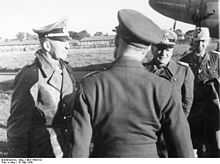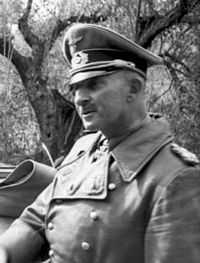Hans-Jürgen von Arnim
| Hans-Jürgen von Arnim | |
|---|---|
|
General von Arnim | |
| Born |
4 April 1889 Ernsdorf, Silesia, Prussia |
| Died |
1 September 1962 (aged 73) Bad Wildungen, Hesse |
| Buried at | Bad Wildungen, Village Cemetery |
| Allegiance |
|
| Service/branch | Heer |
| Years of service | 1907–43 |
| Rank | Generaloberst |
| Commands held |
|
| Battles/wars | |
| Awards | Knight's Cross of the Iron Cross |
Hans-Jürgen Bernhard Theodor von Arnim (German: [ˈaɐ̯niːm]; 4 April 1889 – 1 September 1962) was a German colonel-general (Generaloberst) who served during World War II. He was also a recipient of the Knight's Cross of the Iron Cross (Ritterkreuz des Eisernen Kreuzes).
Early life
Arnim was born in Ernsdorf in the Prussian Province of Silesia, the son of General Hans von Arnim (1861–1931) and Martha Honrichs von Arnim (1865–1953).
Military career
Arnim joined the German Army in 1907. During the First World War he saw action on both the Eastern and Western fronts. After the war, he remained in the Reichswehr and rose to command the elite 68th Infantry Regiment in Berlin. With the rise of Nazi Germany, Arnim was made a major-general in 1938.
World War II
Arnim commanded the 52nd Infantry Division in both the Battles for Poland and France. In October 1940, Arnim was given command of the 17. Panzer-Division. With the outbreak of the war against the Soviet Union, he was promoted to lieutenant general under Heinz Guderian, and was seriously wounded a few days after the start of the campaign.
On 1 October 1941, he was promoted to General der Panzertruppe and placed in command of XXXIX. Panzerkorps until November 1942, when he was appointed commander of the 5th Panzer Army under Erwin Rommel in North Africa. When Adolf Hitler refused to allow Rommel to return to Tunisia, Arnim was promoted to full general (Generaloberst) on 4 December 1942, and made Commander-in-Chief of Army Group Africa from 23 February 1943 until his surrender to the Royal Sussex Regiment of the 4th Indian Division two months later on 12 May 1943.[1] After he was captured, Arnim allegedly expected to be met by his opposite numbers and asked to see Dwight D. Eisenhower. The American general replied to his aides to get as much information out of him as they could, but a personal meeting was out of the question. Eisenhower would not meet with any German officers until the final surrender.[2] Instead Arnim was brought to the British 1st Army commander-in-chief, General Kenneth Anderson.
Von Arnim served the rest of the war as a British prisoner of war interned along with 24 other German general officers at Camp Clinton, Mississippi,[3] and was released on 1 July 1947. He returned to Germany, where the estates he had held before the war had been taken and divided by the Soviet occupation authorities as part of a process of land reform.[4] He died in Bad Wildungen, Hesse.
-

Colonel-General Hans-Jürgen von Arnim (right) welcomes General Gustav von Vaerst; PK "Africa"
-

Generaloberst Hans-Jürgen von Arnim (left) and General der Panzertruppe Hans Cramer (centre) in British captivity at Trent Park camp in 1943
Awards

- Iron Cross (1914)
- 2nd Class (2 November 1914)
- 1st Class (16 September 1914)
- Hanseatic Cross of Hamburg
- Knight's Cross of the Royal House Order of Hohenzollern with Swords (7 September 1918)
- Wound Badge in Silver (1918)
- Honour Cross of the World War 1914/1918
- Clasp to the Iron Cross (1939)
- Knight's Cross of the Iron Cross on 4 September 1941 as Generalleutnant and commander of the 17. Panzer-Division[6][7]
- Mentioned in the Wehrmachtbericht (addendum) on 13 May 1943
- Ärmelband "Afrika"
- Wehrmacht Long Service Award, 1st to 4th classes
- Eastern Front Medal 1941/42
See also
References
- Citations
- ↑ I Was There! - How Von Arnim Surrendered at Last, The War Illustrated, June 11, 1943.
- ↑ ALLIES, by John S. D. Eisenhower
- ↑ "German POW Camp in Clinton MS. Mostly Afrika Corps". kilroywashere.org.
- ↑ Giles MacDonogh, After the Reich, John Murray, 2007, p. 410
- ↑ 5.0 5.1 Federl 2000, p. 19.
- ↑ Fellgiebel 2000, p. 117.
- ↑ Scherzer 2007, p. 194.
- Bibliography
- Alman, Karl (1998). Ritterkreuzträger des Afrikakorps [Knight's Cross Bearers of the Afrika Korps] (in German). Rastatt, Germany: VPM Verlagsunion Pabel Moewig. ISBN 978-3-8118-1457-8.
- Federl, Christian (2000). Die Ritterkreuzträger der Deutschen Panzerdivisionen 1939–1945 Die Panzertruppe [The Knight's Cross Bearers of the German Panzer Divisions 1939–1945 The Panzer Force] (in German). Zweibrücken, Germany: VDM Heinz Nickel. ISBN 978-3-925480-43-0.
- Fellgiebel, Walther-Peer (2000). Die Träger des Ritterkreuzes des Eisernen Kreuzes 1939–1945 – Die Inhaber der höchsten Auszeichnung des Zweiten Weltkrieges aller Wehrmachtteile [The Bearers of the Knight's Cross of the Iron Cross 1939–1945 — The Owners of the Highest Award of the Second World War of all Wehrmacht Branches] (in German). Friedberg, Germany: Podzun-Pallas. ISBN 978-3-7909-0284-6.
- Patzwall, Klaus D.; Scherzer, Veit (2001). Das Deutsche Kreuz 1941 – 1945 Geschichte und Inhaber Band II [The German Cross 1941 – 1945 History and Recipients Volume 2] (in German). Norderstedt, Germany: Verlag Klaus D. Patzwall. ISBN 978-3-931533-45-8.
- Scherzer, Veit (2007). Die Ritterkreuzträger 1939–1945 Die Inhaber des Ritterkreuzes des Eisernen Kreuzes 1939 von Heer, Luftwaffe, Kriegsmarine, Waffen-SS, Volkssturm sowie mit Deutschland verbündeter Streitkräfte nach den Unterlagen des Bundesarchives [The Knight's Cross Bearers 1939–1945 The Holders of the Knight's Cross of the Iron Cross 1939 by Army, Air Force, Navy, Waffen-SS, Volkssturm and Allied Forces with Germany According to the Documents of the Federal Archives] (in German). Jena, Germany: Scherzers Miltaer-Verlag. ISBN 978-3-938845-17-2.
External links
-
 Media related to Hans-Jürgen von Arnim at Wikimedia Commons
Media related to Hans-Jürgen von Arnim at Wikimedia Commons - Redoubt Fortress Museum
| Military offices | ||
|---|---|---|
| Preceded by Generaloberst Karl-Adolf Hollidt |
Commander of 52. Infanterie-Division September 8, 1939 – October 5, 1940 |
Succeeded by Generaloberst Lothar Rendulic |
| Preceded by General der Panzertruppen Wilhelm Ritter von Thoma |
Commander of 17. Panzer-Division September 15, 1941 – November 11, 1941 |
Succeeded by Generalleutnant Rudolf-Eduard Licht |
| Preceded by Generaloberst Rudolf Schmidt |
Commander of XXXIX. Panzerkorps November 11, 1941 – November 30, 1942 |
Succeeded by General der Artillerie Robert Martinek |
| Preceded by Generalfeldmarschall Erwin Rommel |
Commander of Heeresgruppe Afrika March 10, 1943 – May 13, 1943 |
Succeeded by disbanded |
| ||||||||||||||||||||
| |||||||||||||||||||||||||||||||||
|

.svg.png)